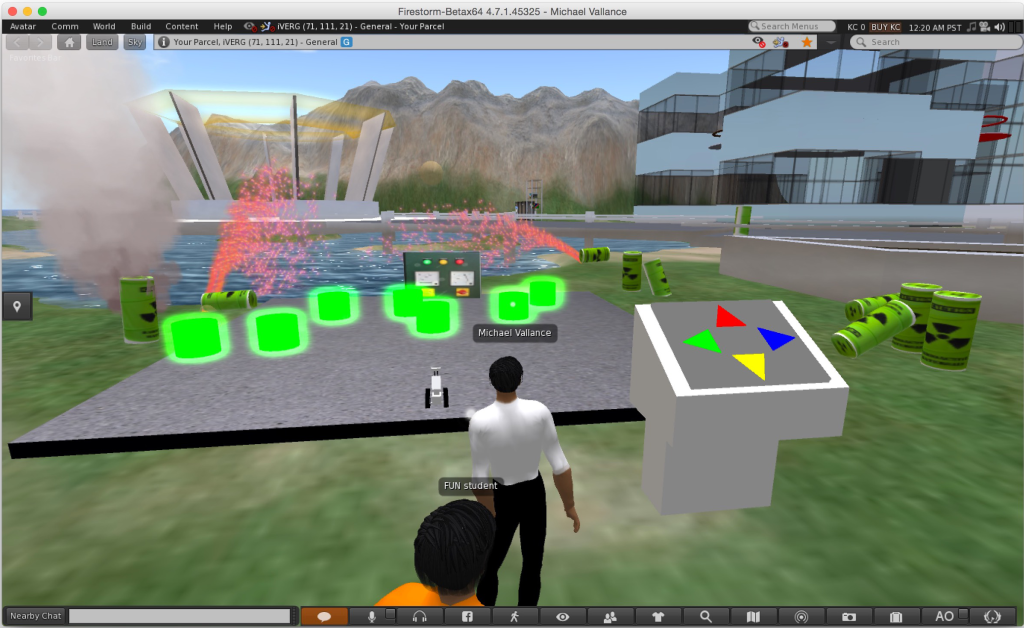 By Dr. Michael Vallance
By Dr. Michael Vallance
Department of Media Architecture,
Future University Hakodate, Japan.
To advance education in the 21st century, experts in neuroscience argue for more ‘active learning’ through experience. A practical implementation for such active, experiential and, we propose, multi-disciplinary learning is for students to consider, analyze, solve and make personal meaning from engaging problems. Collaborative problem-solving promotes communication involving creative and interpretive meaning-making, analysis and reflective judgement. Due to advances in computer technologies, educators can now consider a wider range of collaborative problems and extensive solutions which can be implemented in both real and virtual worlds.
Virtual world participants from Japan, UK and USA have been engaged in remote collaborations to solve problem-based tasks requiring the programming and manouvering of virtual robots and real-world LEGO EV3 Mindstorms robots in a number of virtual world scenarios and technologies. Robot Mediated Interactions are analyzed to determine robot task complexity, student learning and task immersion. Our context is the dumping of nuclear waste bins.
Our learner-centered design approach has enabled a number of innovative tools to be created and customized by the students, with help from external metaverse programmers. For instance, in a prior OpenSim environment a graphical representation of the LEGO robot object left a trace of the circuit in-world, media objects in-world displayed live streamed video from the lab in Japan (using the online UStream service) and also from an iPhone attached to the front of the LEGO robot (using the Bambuser iPhone App), and the use of avatars in-world also enabled UK students to remotely maneuver a real-world robot physically located in Japan. To do this a LabView software VI program communicated with a Windows server file (hosting the OpenSim space) to aid avatar–to- robot communication. As an aside, we also attached a LEAP Motion Controller for hands-free maneuvering of the EV3 robot via the virtual world.
The KITELY space has been set up as a Training Area for students unfamiliar with virtual worlds. Our development and design in KITELY has been basic but the space serves our needs perfectly. It has been easy to set up, falls well within our budget, is reliable, and our small number of avatars can maneuver seamlessly. Virtual noticeboards can be updated with text and images to aid communication. There is a board to access web pages. Most importantly, we also have a virtual robot which can be maneuvered around obstacles. If the robot collides with an obstacle then there is a dramatic explosion and the robot returns to its start point. Obstacles can be randomly located by the owner. We have added some interactivity in-world but do not wish to overwhelm new users. We use the Firestorm version 4.7.1 client on Mac computers at all locations.
For those interested in our research, data from 39 tasks is summarized in our International Journal of Learning Technology paper.
Vallance, M., Martin, S. and Naamani, C. (2015). A situation that we had never imagined: post-Fukushima virtual collaborations for determining robot task metrics. International Journal of Learning Technology, Vol. 10, No. 1, pp.30–49.
Website & contact information at http://www.mvallance.net
Available at http://www.inderscienceonline.com/doi/abs/10.1504/IJLT.2015.069453
We will continue using KITELY for training our students. In future, we would like to set up the ‘bridge’ using KITELY for virtual-to-real world robot maneuvering, and are currently looking into alternatives to our previous ‘OpenSim/ Windows’ server solution.
Robot Mediated Interaction in 3D Virtual Worlds research.
Michael Vallance (Dr) | Professor | Dept. Media Architecture | Future University Hakodate
Email: michael@fun.ac.jp | Web: www.mvallance.net